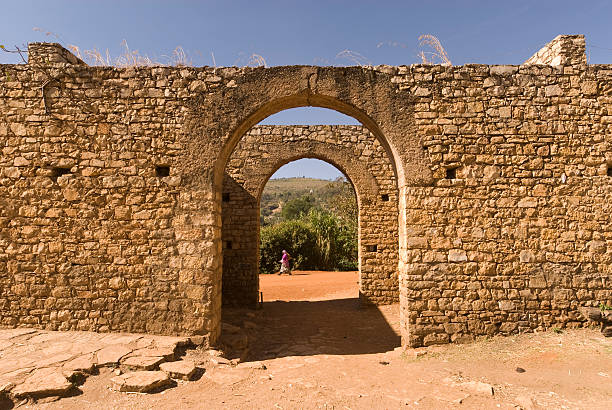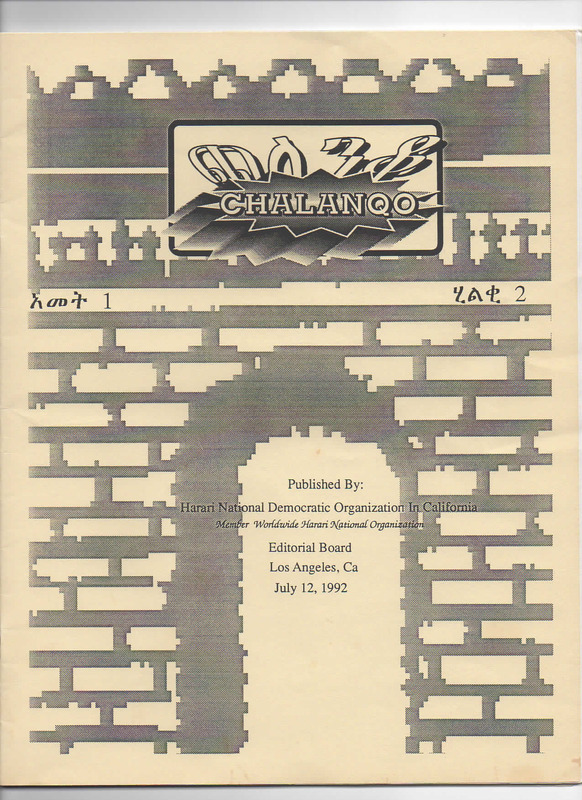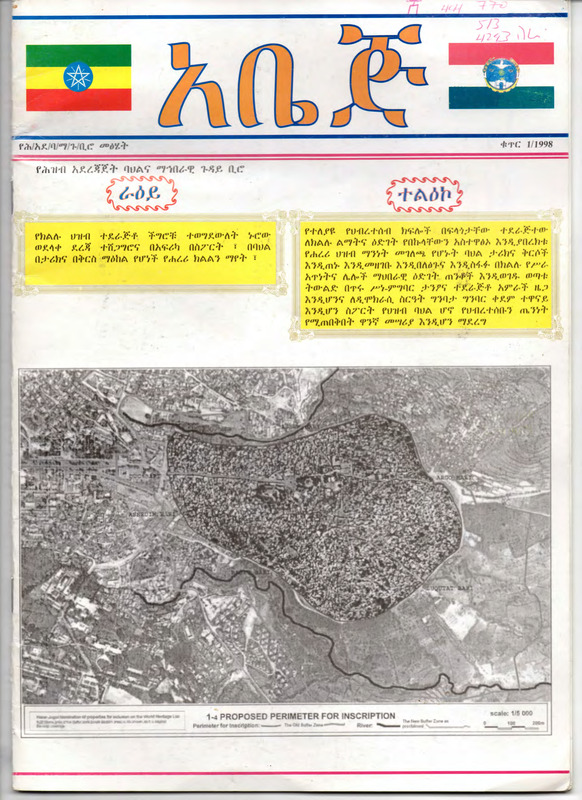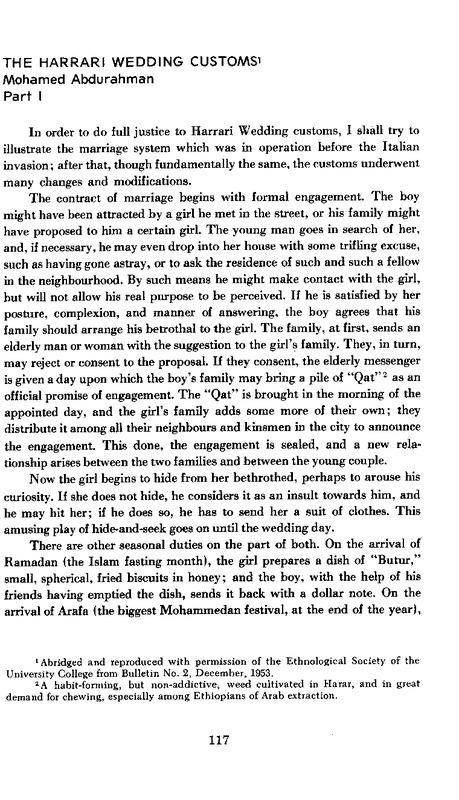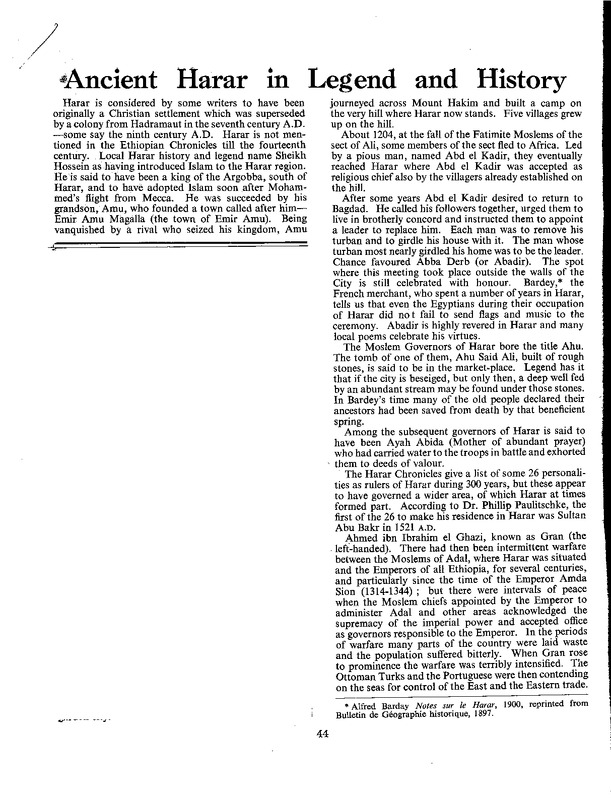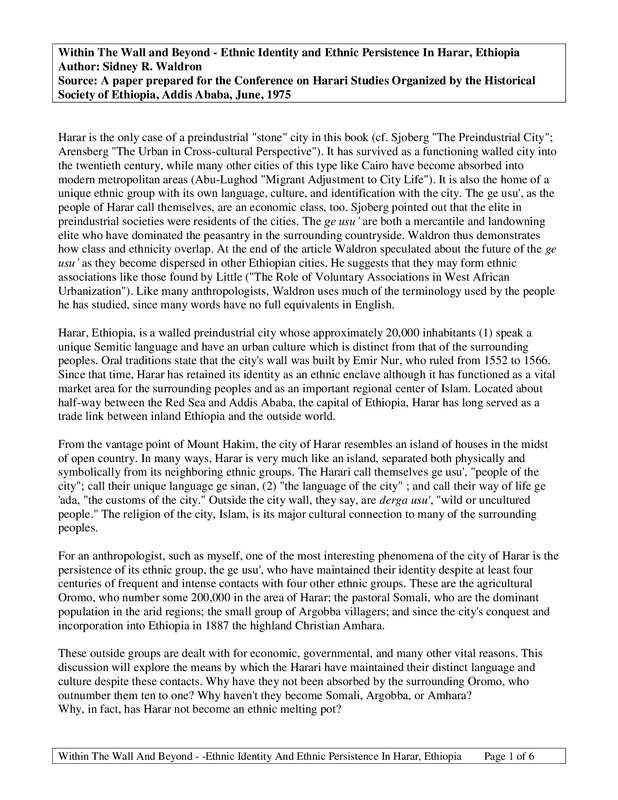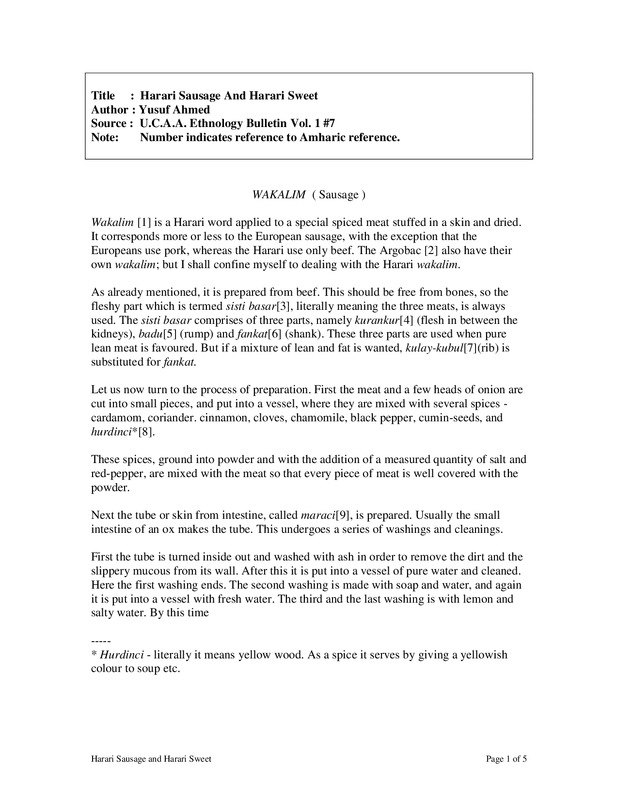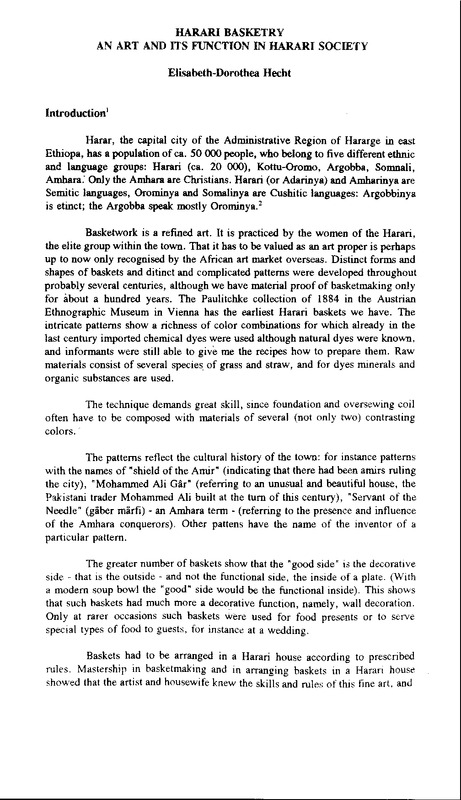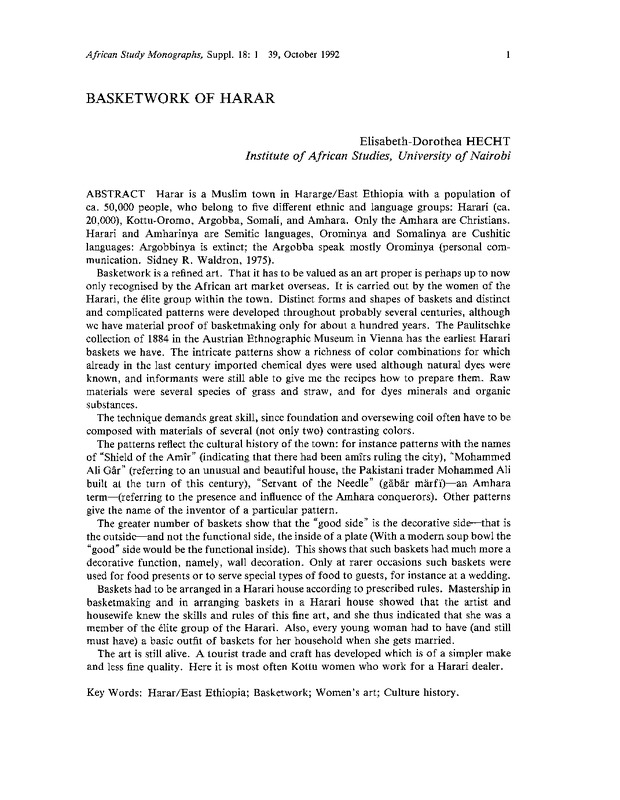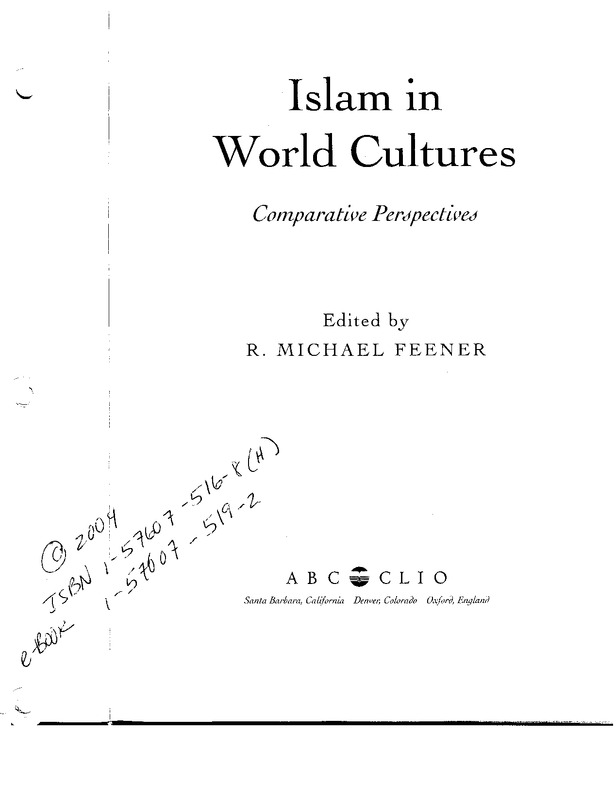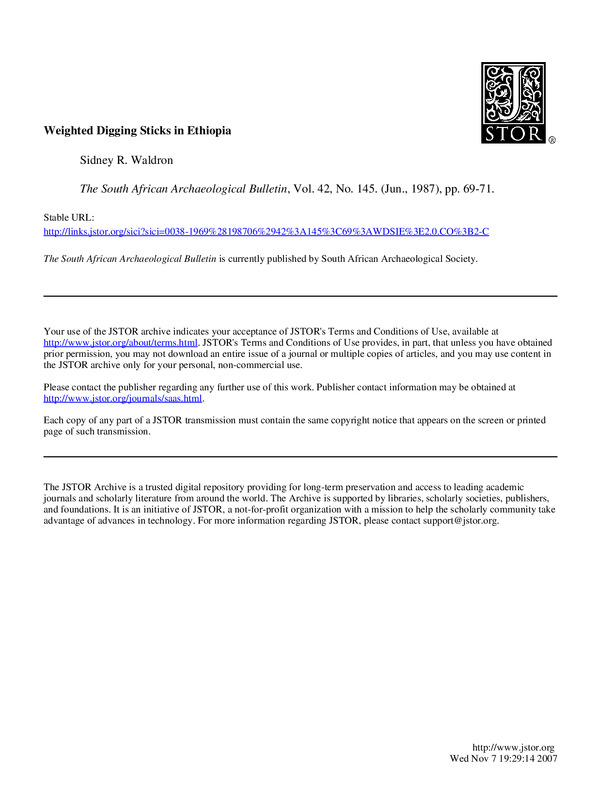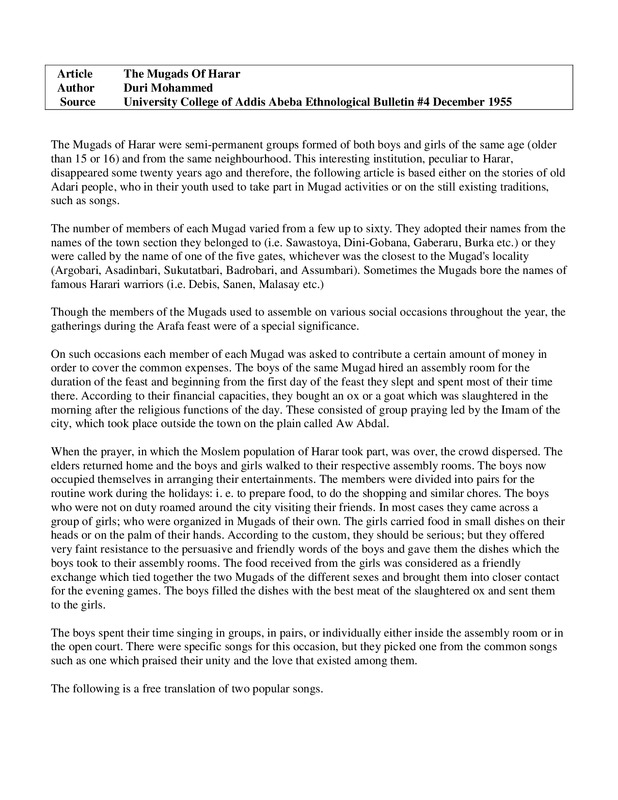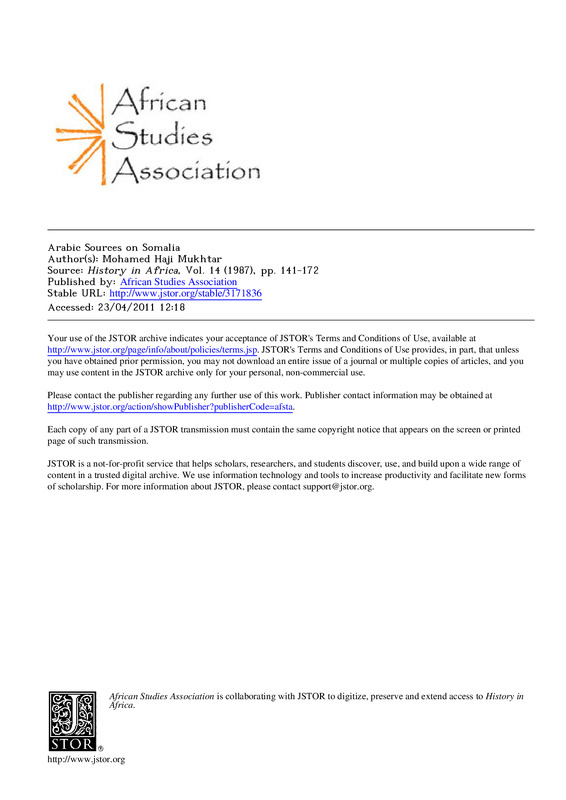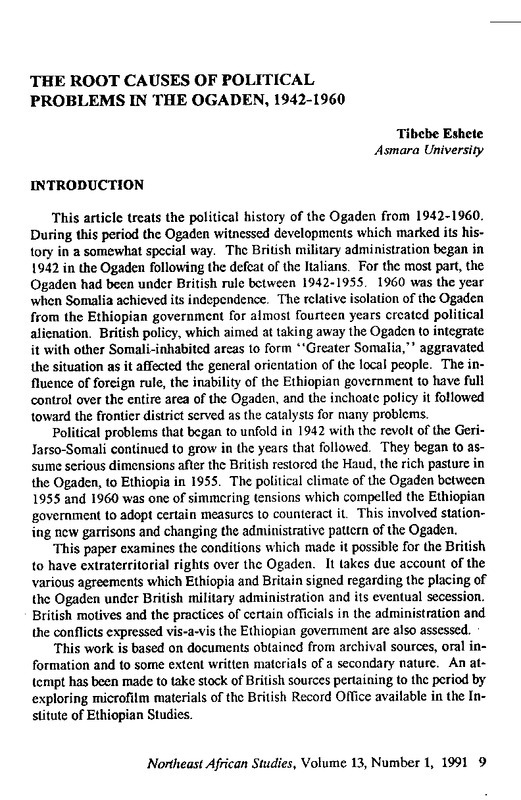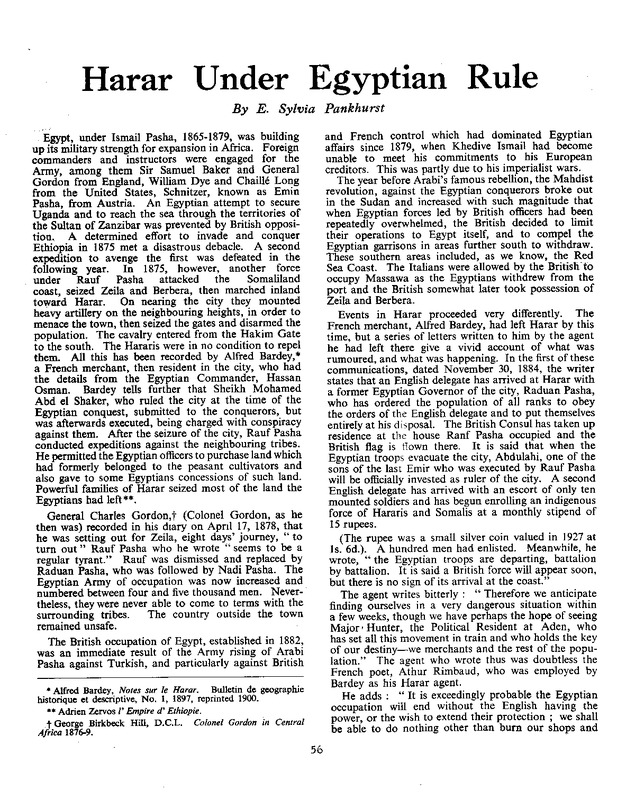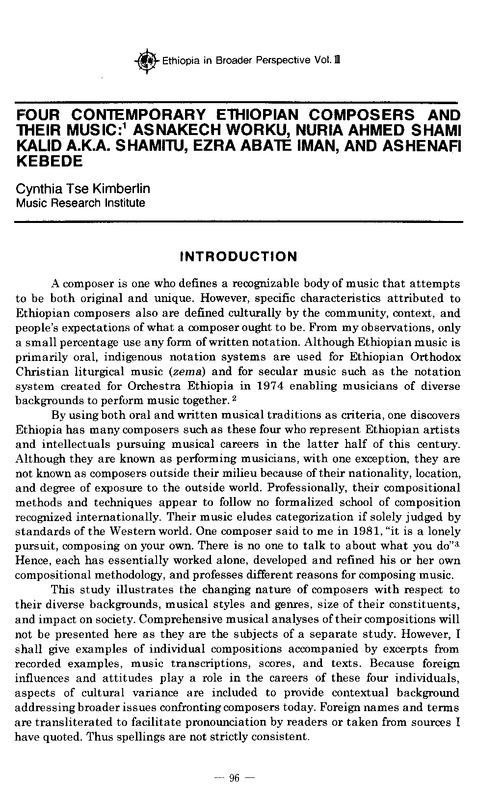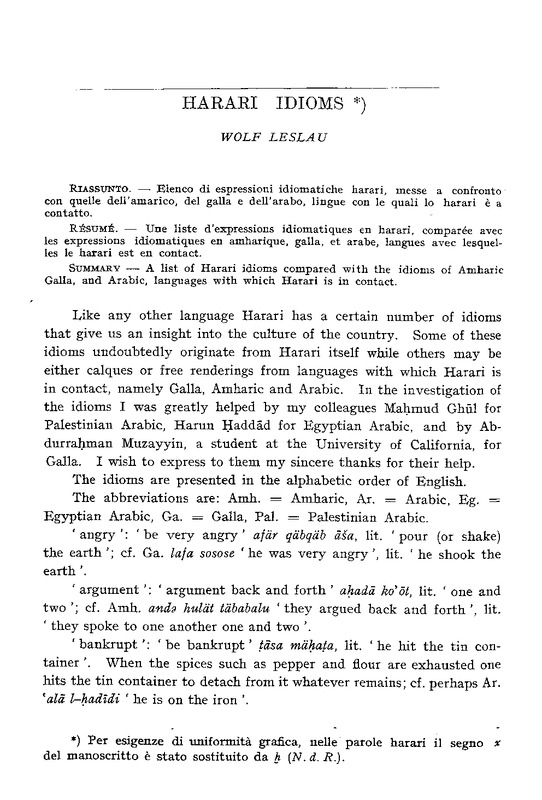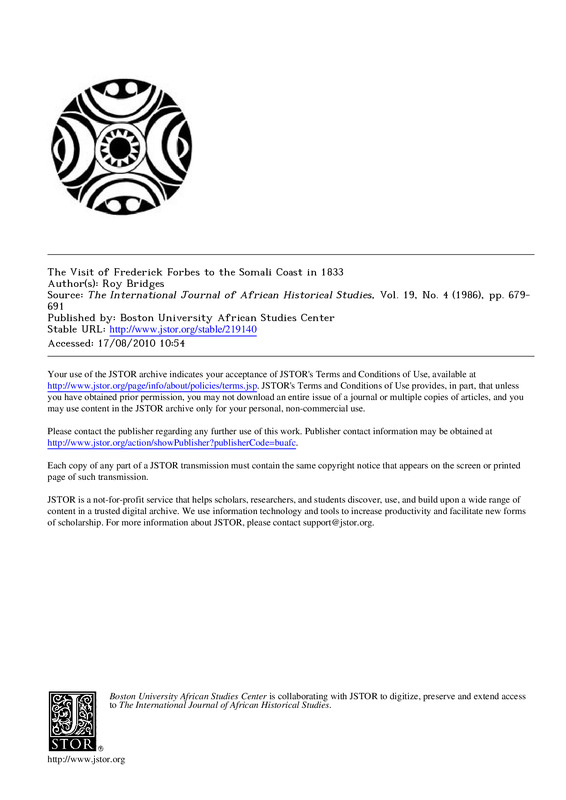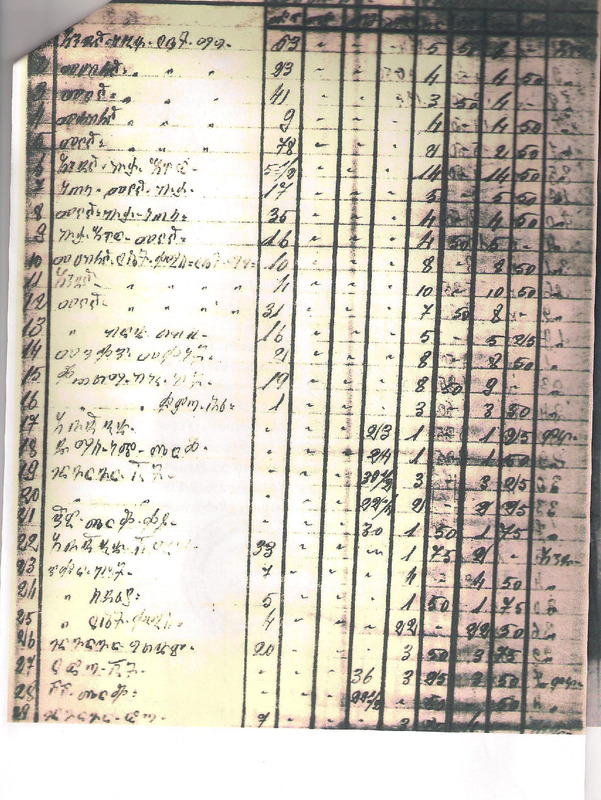Items
-
FalakDate: 1992The paper Discussess the organizations objective and it's future plans including the developing of relationship with Harar and HNL. Articles from Harari organizations located in different cities in US , and Canada are available in the periodical.
-
Chalanqo: Issue I, No:2Date: 1992Articles of Harari social issues, culture, politics and more are discussed.Most part is written in Geez phont except one article, "Harari Wedding" in English.
-
Within The Wall and Beyond - Ethnic Identity and Ethnic Persistence In Harar, EthiopiaDate: 1975Harar is the only case of a preindustrial "stone" city in this book (cf. Sjoberg "The Preindustrial City"; Arensberg "The Urban in Cross-cultural Perspective"). It has survived as a functioning walled city into the twentieth century, while many other cities of this type like Cairo have become absorbed into modern metropolitan areas (Abu-Lughod "Migrant Adjustment to City Life"). It is also the home of a unique ethnic group with its own language, culture, and identification with the city. The ge usu', as the people of Harar call themselves, are an economic class, too. Sjoberg pointed out that the elite in preindustrial societies were residents of the cities. The ge usu’ are both a mercantile and landowning elite who have dominated the peasantry in the surrounding countryside. Waldron thus demonstrates how class and ethnicity overlap. At the end of the article Waldron speculated about the future of the ge usu’ as they become dispersed in other Ethiopian cities. He suggests that they may form ethnic associations like those found by Little ("The Role of Voluntary Associations in West African Urbanization"). Like many anthropologists, Waldron uses much of the terminology used by the people he has studied, since many words have no full equivalents in English.Harar, Ethiopia, is a walled preindustrial city whose approximately 20,000 inhabitants (1) speak a unique Semitic language and have an urban culture which is distinct from that of the surrounding peoples. Oral traditions state that the city's wall was built by Emir Nur, who ruled from 1552 to 1566. Since that time, Harar has retained its identity as an ethnic enclave although it has functioned as a vital market area for the surrounding peoples and as an important regional center of Islam. Located about half-way between the Red Sea and Addis Ababa, the capital of Ethiopia, Harar has long served as a trade link between inland Ethiopia and the outside world.
-
Harari Sausage And Harari SweetDate:Wakalim [1] is a Harari word applied to a special spiced meat stuffed in a skin and dried. It corresponds more or less to the European sausage, with the exception that the Europeans use pork, whereas the Harari use only beef. The Argobac [2] also have their own wakalim; but I shall confine myself to dealing with the Harari wakalim.Mutabbak[1] is a small round sweet made of sesame seed and honey. It is usually prepared for a marriage feast, when it is provided by the bride's parents and for kalam-masbar*.[2] But now some people, mostly Arabs, have begun to sell it as a sweet under the name of mugalgal.
-
Basket Works Of Harar Part 2 of 2Date: 1979
-
Basket Works of Harar Part 1 of 2Date: 1992
-
Harari Moslims in Christian EthiopiaDate:Religion language, and Nationalism of Hararies. It is Chapter eight of Islam in Comparitive Cultures.
-
Weighted Digging Sticks in EthiopiaDate: 1987The weighted digging stick (Fig. 1) is an integralcomponent of the toolkit employed in agriculture in thevicinity of the old walled city of Harar, Ethiopia (see note 1)where it is primarily used as a tilling instrument in soilsunsuitable for the simple Ethiopian plough
-
Mugads Of HararDate: 1955The Mugads of Harar were semi-permanent groups formed of both boys and girls of the same age (older than 15 or 16) and from the same neighbourhood. This interesting institution, peculiar to Harar, disappeared some twenty years ago and therefore, the following article is based either on the stories of old Adari people, who in their youth used to take part in Mugad activities or on the still existing traditions, such as songs.
-
Arabic Sources on SomaliaDate: 1987Kilwa is a second Mawsim, and from Kilwa to al-Qumur is a third III The Formation of Islamic Centers If the immigration to Abyssinia in the very early years of Islam represented the first contact of Muslims with the Horn of Africa, Ibn Hishim’s aZ-S’ra al-Nabawiyyah is a first-hand source on this issue. The Somaliland forming a part of the Arab world is very clear in Ibn Hawqal’s map of Diyar al-CArab (the Arab Homeland). Besides the above-mentioned map of Diyar al- Arab Ibn Hawqal also drew other different maps of the Muslim World, and also a map of the World in his Kitab STrat aZ-Ard (the Shape of the Earth). This work was printed in Leiden in 1938. Al-MaqdisT (d. 990) in his Ahsan al-Taq5asm fT Macrifat al- AqTaZm (on World Regional Geography), pointed very clearly to the existence of Muslim centers along the coastal strip of Somalia, and mentioned Zeila as the biggest Muslim center in the Autal (Awdal) land. As well, al-YaCqibi (d. 905) in his al- BuZdjn (The Countries) was the first Arabic writer to mention Zeila as a Muslim center in the Berber coast. From the thirteenth century onwards Muslim scholars began writing on the history, geography, and issues related to the Muslim world using a new and different approach. They started putting all the information that they had witnessed, had been told to them, or had been collected from other written sources into huge books called “Al-MawsTiah” (the Encyclopaedias). Most Muslim writings of that style contained some information about Somaliland and Muslims of the Horn of Africa. But the most important of the MawsuCah to mention Somalia was the one written by Ibn Fadl al-cUmari (1301-1349). Entitled Mas-Zik al-Absar fiMamalik al-Amsacr, this MawsuCah gives us detailed information about the formation of early Muslim centers in the hinterland of the Horn of Africa. Unfortunately this work remains unpublished. A copy of it is available as Ms. in Oxford University Library (Ms. Pococke 191, Bod.). Then Ibn Khaldun,7 recalling Ibn Sacrd and Aba al-Fida’s accounts,8 provided additional information about the early days of Muslim rulers of the region. Ibn Batuta (1304-1377) is unique among the travelers of his time. His descriptions are more accurate and his analyses more plausible. From his account we learn that Somali Muslim centers were giving great importance to education. Students from far places were given lodgings and food, and Ibn Batuta himself was lodged in the students’ house in Mogadishu during his visit to Somalia, which took place in 1331. His eyewitness accounts are recorded in his book, Tuhfat al-Nazzar fr Ghara’b al-Amsar Wa144 MOHAMEP HAJI MUKHTAR CAja’b aZ-Asfar, known as “RihZat Ibn Batuta” (Voyages of Ibn Batuta).9 IV The Struggle Between Islam and Christianity in the Horn As we have already seen, Islam was spreading inland from the coast along the main rivers, the Shabelle and the Juba, using the Zeila-Harar trade route into the highlands of Abyssinia and, from the sixth century of Islam, founding kingdoms known as “Mamnlik al-Tiriz al-IslgmT” (the edge of Muslim kingdoms). Al- Maqrizr (1364-1442) provided one of the authoritative accounts of the struggle between the Muslim sultanates and Christian kingdoms in his AZ-IZmcm man bi Ard al-Habashah Min MulLJTa Z-IsZ7m , (a survey of the Moslem Princes in Abyssinia). It is also very important to mention another book by the same author called AZDhahab aZ-Masbik ff Dhikr man Hajja min aZ-KhuZafS’wa-aZ-MuZl7k (a book on those caliphs and kings who went on the Pilgrimage during 1435-1437). This book contains interviews, collected by the author over these three years of his own stay in Mecca, with pilgrims from many parts of the Muslim world and especially Africa. H~mid cImarah is another scholar who has studied this issue and his book CAZ3q-t al-Dawlah al-MamZukiyah bi al-Duwal al-Ifr’qiyah (the relations between the Mamluk state of Egypt and the African States), covers the relations between Egypt and Abyssinia during the Mamluk Dynasty. No less important as a source is the encyclopaedic type of book by al-Qalqashandl (1355-1481) known as SubhT aZ-ACshf7a Sinacat al- Insha’. This book is in fourteen volumes, and the major part of volumes 5, 6, and 8 deals with the Muslim Sultanates of the Horn of Africa and their struggle with Christian Kingdoms of Abyssinia. Although Muslim historians and geographers devoted much attention to the Muslims of east Africa and the Horn, the most significant account of the relations between Islam and Christianity in the region is Tuhfat aZ-Zaman, known as Futuh aZ-Habasha (the conquest of Abyssinia). The importance of this book is that Shihab al-Din, the writer, was an eyewitness to many of the events which he recorded, as he accompanied the Imam (Ahmad Gurey) in his conquests in Abyssinia between 1506 and 1542.10
-
Harla: Ethiopia's lost civilizationDate: 2011Eastern Ethiopia's history is shrouded in mystery. Most archaeologists investigate early hominids like Lucy, the famous Australopithecus afarensis, or study the great civilizations of the north like Gondar and Axum. The east, though, is virtually unknown, and only enigmatic ruins and strange legends remain.Scattered around eastern Ethiopia all the way to Somaliland and the Red Sea are the ruins of towns with large stone buildings unlike anything made by the modern Oromo and Somali peoples. These are the remnants of the little-known Harla civilization. Wanting to learn more, I contacted archaeologist, author, and Harar tour guide Muhammed Jami Guleid (guleidhr @yahoo.com). "Dake", as everybody here calls him, helped me travel to Somaliland last year and is an invaluable resource for local culture and history. He knows everybody and he's excavated Harla graves in Ethiopia's Somali region and in Somaliland.They were a race of giants, people say, and immensely strong. They'd perform amazing feats of strength like playing with balls made from the entire hide of a goat. A schoolkid we gave a lift to told us the Harla were three meters tall! This rumor probably came about because of their unusual graves. They're long and thin, sometimes three or four meters long, although the skeletons in them aren't unusually tall. The graves are usually covered with a layer of ash (probably from burnt offerings), the skeleton of a sacrificed cow, and below that a stone slab sealing the tomb.
-
Qat culture in Harar: East Africa's favorite legal highDate: 2011Every afternoon in Harar, you see men walking along carrying plastic bags filled with leaves. Hararis aren't big fans of salads; they're chewing these leaves for a completely different reason. It gets them high.Qat (pronounced "chat" in Harari, Amharic, and Somali) is a narcotic leaf from a fast-growing bush found all over the Horn of Africa and Yemen. It's legal and hugely popular in this region.In Harari culture it's mostly the men who chew, although some women do as well. Many people have a regular birtcha (qat-chewing session) where they meet most afternoons to socialize and work.I'm not going to be coy like some travel writers and talk about drugs in foreign countries while pretending I haven't used them. When I'm in Harar I chew qat regularly. I attend a birtcha at the home of a man who works in one of the government bureaus. Birtchas usually attract people who have similar jobs, political views, or who are friends from childhood. My birtcha includes dictionary writers, government workers, and a public prosecutor. A birtcha gives people a chance to while away the afternoon in conversation.
-
Harar, Ethiopia: Two months in Africa's City of SaintsDate: 2011What makes an adventure traveler return to a place he's been before? When so many other destinations beckon, why spend two months in a town you've already seen?Because there's so much more to see. Harar, in eastern Ethiopia between the lush central highlands and the Somali desert, can take a lifetime to understand. For a thousand years it's been a crossroads of cultures, where caravans from the Red Sea met Central African merchants, where scholars and poets have traded ideas, where a dozen languages are heard in the streets.Harar's influence spread wide in those early days. Harari coins have been found in India and China, and a couple of my Harari friends have subtly Chinese features.The Harari have always mixed with other tribes. Some say if you live within the medieval walls of the Jugol, the old city, and follow Harari ways, that you are one of them. Hararis have their own language spoken only by the Jugol's 20,000 residents, yet this language has created literature, poetry, and song for centuries. As Harar faces the new millennium, a dedicated group of artists and intellectuals are working to preserve and add to this heritage
-
Poetry and music in the "City of Saints"Date:The ancient city-state of Harar, a micro-cultural island in Eastern Ethiopia, has been for centuries a crucial commercial crossroad and the major East African Islamic centre. Harar’s inhabitants call their town simply Gey, “the City”, or Jugol, the wall that encloses and symbolizes it, but Harar is also named Madinat al-Awliya “City of Saints”, as it is starred with hundreds of mosques, shrines and tombs of holy men. For Harari people, an urban, literate and highly educated population, ada (culture) and din (religion) are strictly interlocked. Harari songs, called gey fäqär, “the Songs of the City”, are among the most signifcant expressions of local intangible cultural heritage. The Songs of the City, unique and diverse at once, openly represent Harari identity and concurrently reveal local intercultural adjustments and reactions to historical processes. Today, Harari songs are mainly performed at weddings and tell about the new life of the newly-wedded couple. However, texts of gey fäqär also constantly refer to Islamic religion, as well as to historical memory, patriotism and cultural identity.
-
Four Contemporary Ethiopian Composers and their MusicDate: 1997...At thirteen she decided to become a vocalist, despite vehemnet from family and friendswho insulted her and despised the fact that she sang in public. Shamitu married in thirteen…
-
Harari IdiomsDate: Harari Idioms
-
THE VISIT OF FREDERICK FORBES TODate: 1833Previous issues of this journal have carried information about early nineteenthcenturyvisits to the northern coast of Somalia by John Studdy Leigh, whoclaimed that he and not Richard Burton was the first European to succeed inpenetrating inland to the city of Harar. Leigh's claim was made in 1892 and hesaid his trip had been made in 1838-1839.1 Although Marcus and Page gave somecautious credence to Leigh's story, Kirkman subsequently showed that theevidence of Leigh's own journal proved that although he had been at Berbera in1838-1839, he had definitely not gone inland to Harar.2 The journal entries alsothrow doubt upon another of Leigh's assertions of 1892: that the people ofBerbera regarded him as "the first European that has visited . . . within .
-
The Ill Treatment Of Hararies By Haileselassies's Government Police MachinaryDate: 1948The document lists names of Hararies wanted by Haileselasie goveronment as stated for their involvment in the Harari Movement of the 1940s. The persons named are accused of multiple charges, some supporting the movement, emigrating , for mailing letters from and to foreign countries and others with charges of propagnda and financial assisstance. Document available In Abdela Sherif museum

